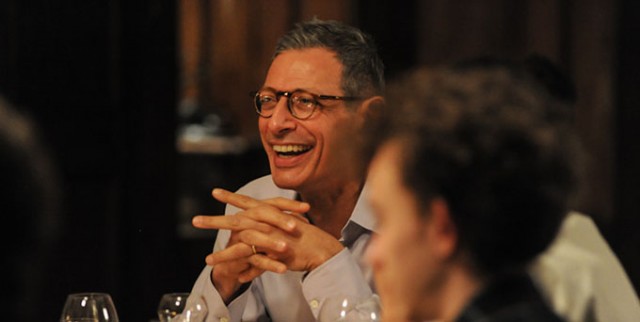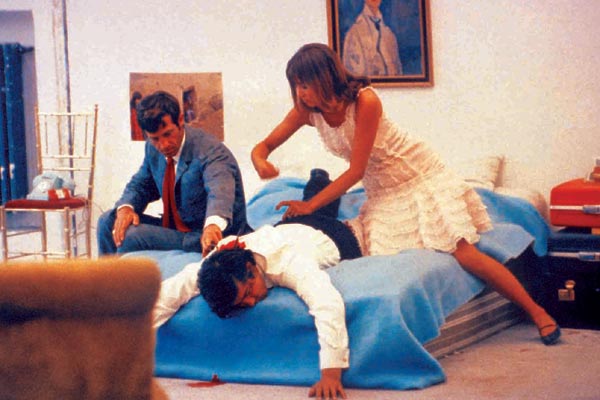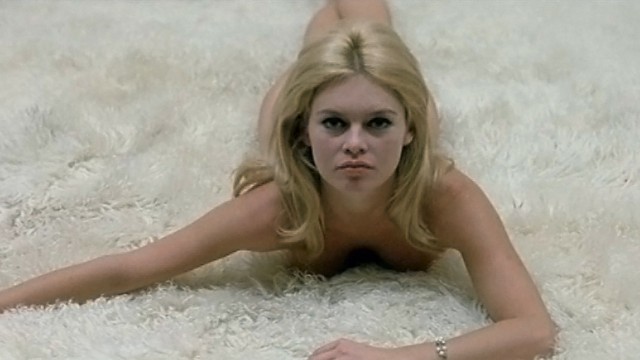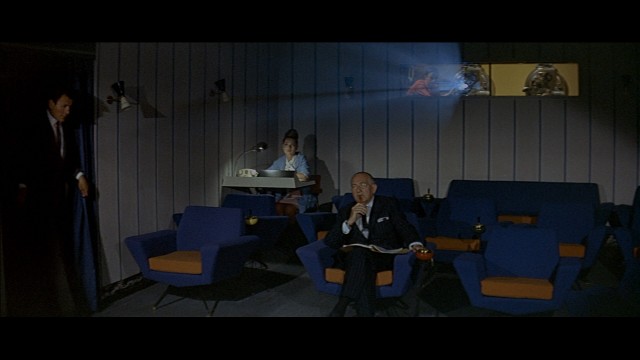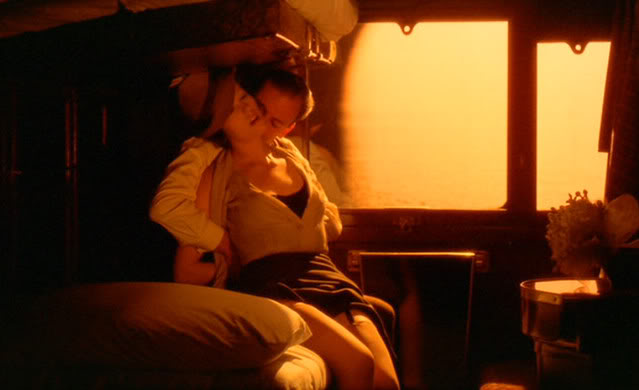BANDE À PART (BAND OF OUTSIDERS) (Jean-Luc Godard, 1964)
Film Society of Lincoln Center
Elinor Bunin Munroe Film Center, Francesca Beale Theater
144 West 65th St. between Broadway & Amsterdam Ave.
Friday, October 18, 7:40
Series continues through October 31
212-875-5601
www.filmlinc.com
 When a pair of disaffected Parisians, Arthur (Claude Brasseur) and Franz (Sami Frey), meet an adorable young woman, Odile (Anna Karina), in English class, they decide to team up and steal a ton of money from a man living in Odile’s aunt’s house. As they meander through the streets of cinematographer Raoul Coutard’s black-and-white Paris, they talk about English and wealth, dance in a cafe while director Jean-Luc Godard breaks in with voice-over narration about their character, run through the Louvre in record time, and pause for a near-moment of pure silence. Godard throws in plenty of commentary on politics, the cinema, and the bourgeoisie in the midst of some genuinely funny scenes. Band of Outsiders is no ordinary heist movie; based on Dolores Hitchens’s novel Fool’s Gold, it is the story of three offbeat individuals who just happen to decide to attempt a robbery while living their strange existence, as if they were outside from the rest of the world. The trio of ne’er-do-wells might remind Jim Jarmusch fans of the main threesome from Stranger Than Paradise (1984), except Godard’s characters are more aggressively persistent. One of Godard’s most accessible films, Band of Outsiders is screening October 18 at the Francesca Beale Theater as part of the expansive Film Society of Lincoln Center series “Jean-Luc Godard — The Spirit of the Forms,” which continues through October 31 with such other Godard works as Les Carabiniers, La Chinoise, Contempt, Film Socialisme, King Lear, Nôtre musique, and many more.
When a pair of disaffected Parisians, Arthur (Claude Brasseur) and Franz (Sami Frey), meet an adorable young woman, Odile (Anna Karina), in English class, they decide to team up and steal a ton of money from a man living in Odile’s aunt’s house. As they meander through the streets of cinematographer Raoul Coutard’s black-and-white Paris, they talk about English and wealth, dance in a cafe while director Jean-Luc Godard breaks in with voice-over narration about their character, run through the Louvre in record time, and pause for a near-moment of pure silence. Godard throws in plenty of commentary on politics, the cinema, and the bourgeoisie in the midst of some genuinely funny scenes. Band of Outsiders is no ordinary heist movie; based on Dolores Hitchens’s novel Fool’s Gold, it is the story of three offbeat individuals who just happen to decide to attempt a robbery while living their strange existence, as if they were outside from the rest of the world. The trio of ne’er-do-wells might remind Jim Jarmusch fans of the main threesome from Stranger Than Paradise (1984), except Godard’s characters are more aggressively persistent. One of Godard’s most accessible films, Band of Outsiders is screening October 18 at the Francesca Beale Theater as part of the expansive Film Society of Lincoln Center series “Jean-Luc Godard — The Spirit of the Forms,” which continues through October 31 with such other Godard works as Les Carabiniers, La Chinoise, Contempt, Film Socialisme, King Lear, Nôtre musique, and many more.
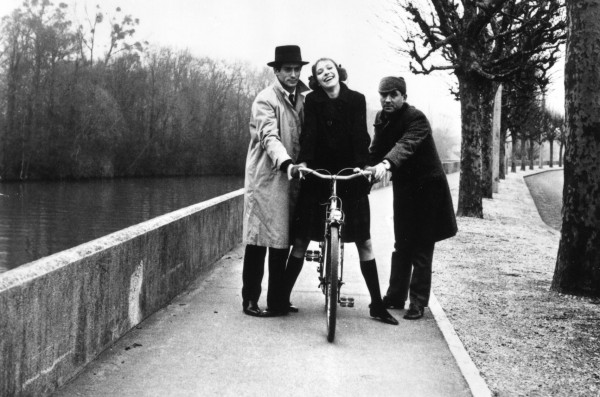
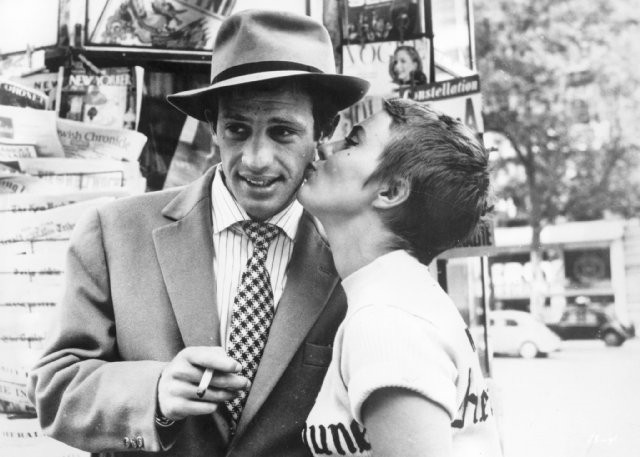
 The recent fiftieth-anniversary restoration of Jean-Luc Godard’s Nouvelle Vague classic, Breathless, which came out in 2010, will leave audiences, well, breathless. Godard’s first feature-length film, buoyed by an original treatment by François Truffaut and with Claude Chabrol serving as technical adviser, is as much about the cinema itself as it is about would-be small-time gangster Michel Poiccard (an iconic Jean-Paul Belmondo), an ultra-cool dude wandering from girl to girl in Paris, looking for extra helpings of sex and money and having trouble getting either. Along the way he steals a car and shoots a cop as if shooing away a fly before teaming up with Patricia Franchini (Jean Seberg) and heading out on the run. Godard references William Faulkner and Dashiell Hammett, Humphrey Bogart and Sam Fuller as Michel and Patricia make faces at each other, discuss death, and are chased by the police. Anarchy prevails, both in Belmondo’s character and the film as a whole, which can go off in any direction at any time. Godard himself shows up as the man who identifies Michel, and there are also cameos by New Wave directors Jean-Pierre Melville and Jacques Rivette. The beautiful restoration, supervised by the film’s director of photography, Raoul Coutard, also includes a new translation and subtitles that breathe new life into one of cinema’s greatest treasures. Breathless is screening in a 35mm print October 15 at 9:30 at the Walter Reade Theater as part of the expansive Film Society of Lincoln Center series “Jean-Luc Godard — The Spirit of the Forms,” which continues through October 31 with such other Godard works as British Sounds, Comment ça va, Détective, Every Man for Himself, First Name: Carmen, France/Tour/Detour/Deux enfants, and many more.
The recent fiftieth-anniversary restoration of Jean-Luc Godard’s Nouvelle Vague classic, Breathless, which came out in 2010, will leave audiences, well, breathless. Godard’s first feature-length film, buoyed by an original treatment by François Truffaut and with Claude Chabrol serving as technical adviser, is as much about the cinema itself as it is about would-be small-time gangster Michel Poiccard (an iconic Jean-Paul Belmondo), an ultra-cool dude wandering from girl to girl in Paris, looking for extra helpings of sex and money and having trouble getting either. Along the way he steals a car and shoots a cop as if shooing away a fly before teaming up with Patricia Franchini (Jean Seberg) and heading out on the run. Godard references William Faulkner and Dashiell Hammett, Humphrey Bogart and Sam Fuller as Michel and Patricia make faces at each other, discuss death, and are chased by the police. Anarchy prevails, both in Belmondo’s character and the film as a whole, which can go off in any direction at any time. Godard himself shows up as the man who identifies Michel, and there are also cameos by New Wave directors Jean-Pierre Melville and Jacques Rivette. The beautiful restoration, supervised by the film’s director of photography, Raoul Coutard, also includes a new translation and subtitles that breathe new life into one of cinema’s greatest treasures. Breathless is screening in a 35mm print October 15 at 9:30 at the Walter Reade Theater as part of the expansive Film Society of Lincoln Center series “Jean-Luc Godard — The Spirit of the Forms,” which continues through October 31 with such other Godard works as British Sounds, Comment ça va, Détective, Every Man for Himself, First Name: Carmen, France/Tour/Detour/Deux enfants, and many more.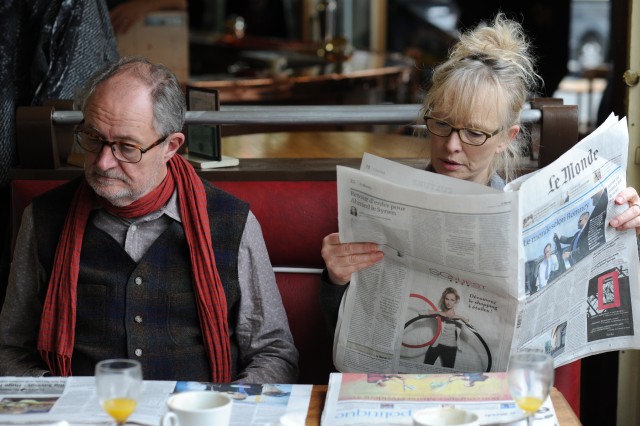
 Mike Nichols’s Who’s Afraid of Virginia Woolf? meets Richard Linklater’s “Before” series in Roger Michell’s bittersweet romantic black comedy, Le Week-end. Professor Nick Burrows (Jim Broadbent) and teacher Meg Burrows (Lindsay Duncan) are celebrating their thirtieth wedding anniversary by returning to Paris, where they spent their honeymoon. But whereas their first visit was filled with love, hope, and dreams of a bright future, they have come to the realization that their life together didn’t quite turn out as planned. While Nick still seems to be in love with his wife, Meg is reevaluating their relationship, continually lashing into him and spending what little money they have with reckless abandon. When they unexpectedly bump into an old colleague of Nick’s, the self-absorbed chatterbox Morgan (Jeff Goldblum), they are invited and go to a party where they imagine what could have been, forcing them to face some brutal truths.
Mike Nichols’s Who’s Afraid of Virginia Woolf? meets Richard Linklater’s “Before” series in Roger Michell’s bittersweet romantic black comedy, Le Week-end. Professor Nick Burrows (Jim Broadbent) and teacher Meg Burrows (Lindsay Duncan) are celebrating their thirtieth wedding anniversary by returning to Paris, where they spent their honeymoon. But whereas their first visit was filled with love, hope, and dreams of a bright future, they have come to the realization that their life together didn’t quite turn out as planned. While Nick still seems to be in love with his wife, Meg is reevaluating their relationship, continually lashing into him and spending what little money they have with reckless abandon. When they unexpectedly bump into an old colleague of Nick’s, the self-absorbed chatterbox Morgan (Jeff Goldblum), they are invited and go to a party where they imagine what could have been, forcing them to face some brutal truths.